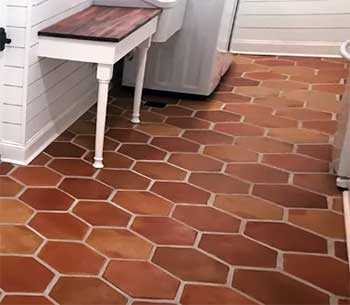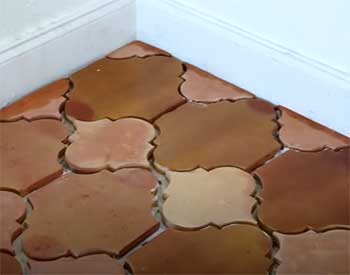If you’re looking to add new tile to your home, you may be debating between saltillo and terracotta tile. Both are types of clay-based tiles that share some similarities but also have key differences.
In this comprehensive guide, we’ll dive into the pros, cons, costs, and considerations for using Saltillo tile and Terracotta tile so you can decide which is the best fit for your needs.
A Brief Comparison Table
| Feature | Saltillo Tile | Terracotta Tile |
| Composition | Made from natural clay with low iron oxide content | Made from clay with higher iron oxide content |
| Color | Variations of orange, tan, brown, yellow and red within each tile | Consistent reddish-orange hue throughout each tile |
| Texture | Uneven handmade texture with more surface irregularities | Smoother and more uniform texture |
| Patterns/Styles | Mostly plain tiles with some decorative options | Many decorative shapes, patterns and accents available |
| Durability | Extremely durable and resistant to cracking | Durable but more prone to chipping on edges |
| Maintenance | Very low maintenance, usually doesn’t require sealing | Requires sealing to prevent staining |
| Slip Resistance | Excellent traction from rough texture | Less slip resistant than saltillo |
| Installation | More difficult due to uneven sizes; shims often required | Easier installation thanks to uniform sizes |
| Outdoor Use | Can withstand freezing/thawing cycles outdoors | Should not be used outdoors where there is freeze/thaw |
| Cost | Affordable, starts around $3-7 per square foot installed | More expensive, starts around $5-15 per square foot installed |
Overview of Saltillo Tile

Saltillo tile is a type of terra cotta tile that originates in Mexico. It’s made from natural clay which gives it beautiful earthy tones and variations. The clay is shaped and fired at a very high temperature which makes the tiles incredibly durable and resistant to cracks.
Saltillo tiles come in a range of warm natural colors like orange, red, tan, brown and yellow. They have a slightly uneven, handmade appearance since each tile is molded individually. The variations in color and texture provide a lot of visual interest and character.
Some of the key benefits of saltillo tile include:
- Durable – Since they are fired at high heat, saltillo tiles stand up very well to heavy foot traffic. They are less prone to chips and cracks than other natural stone and clay tiles.
- Resists Moisture – The dense clay holds up to moisture, making saltillo a good option for kitchens, entries and bathrooms. They won’t easily stain or warp when exposed to water.
- Easy Maintenance – Saltillo tile requires very little maintenance compared to other tile options. Just sweep or mop occasionally.
- Slip Resistant – The natural texture gives saltillo tiles a slip resistant surface, making them safe to use in wet areas.
- Affordable – Saltillo tiles are very competitively priced compared to other handmade tile options.
- Great for Outdoors – With their durability and slip resistance, saltillo tiles work beautifully for outdoor patios, walkways and pool surrounds.
Overall, saltillo offers great value and beauty as a low maintenance, resilient flooring option.
Terracotta Tile
Terracotta tiles are also made from natural clay that is shaped and fired at high temperatures. The clay used for terracotta tiles contains higher iron oxide levels which gives the tiles their signature reddish-orange color.
Terracotta comes in a few different styles:
- Plain terracotta has a smooth matte surface and consistency of color.
- Glazed terracotta has a shiny glass coating applied to create different looks and increase stain resistance.
- Decorative terracotta incorporates design details like patterns, accents and shape variations.
Like saltillo, terracotta is very durable, slip resistant, easy to clean and affordable. Key benefits include:

- Vibrant Color – The terracotta clay holds rich, warm red and orange hues very well. The color goes throughout the tile so it won’t fade or wear away.
- Versatile Styles – From traditional Moroccan-inspired patterns to modern interpretations, terracotta comes in endless design options to match any style.
- Resistant to Temperature Changes – Terracotta tolerates fluctuations in temperature very well and won’t crack from heating or cooling.
- Environmentally Friendly – As a natural clay product, terracotta is more eco-friendly than tile containing synthetics or plastic.
- Provides Heat – The dense clay helps absorb, retain and radiate heat in a space.
For certain applications, terracotta may be preferred over saltillo and other types of tile.
Key Differences Between Saltillo and Terracotta
While saltillo and terracotta share the same clay construction and firing process, there are some notable ways they differ:
- Color
The clay used for terracotta contains more iron oxide, giving it a more distinctively red/orange color throughout. Saltillo tiles exhibit wider variation in earth tones and muted colors within each tile.
- Texture
Saltillo has more noticeable texture and irregularities since each tile is handmade. Terracotta usually has a smoother, more consistent finish.
- Maintenance
Terracotta is more prone to scuff marks and stains than saltillo. Saltillo’s rough texture helps hide everyday wear and small damages. Sealing terracotta tiles is highly recommended.
- Installation
Saltillo tiles tend to have wider thickness variations that make installation more labor intensive. Shims are often needed to level each tile during setting. Terracotta has a more uniform shape for faster installation.
- Outdoor Use
With their greater density and hardness, saltillo tiles resist freezing/thawing damage better if used outdoors. Terracotta should not be used in cold climates or freeze/thaw areas.
- Styling
Terracotta comes in a wider range of decorative patterns, shapes, accents and colors. Saltillo has a more limited style selection.
- Cost
Good quality terracotta tiles generally cost a bit more than saltillo. But saltillo’s labor intensive installation can make the total project cost higher.
Saltillo Tile Pros and Cons
| Pros | Cons |
| Very durable and long lasting | Higher installation cost |
| Resists cracking and chipping | Limited style selection |
| Stays cool underfoot in warm climates | Needs sealing for moisture protection |
| Provides great traction and slip resistance | Color variations may look patchy |
| Affordable compared to other natural tiles | Difficult to cut onsite for adjustments |
| Easy maintenance without sealing | Porous surface can stain |
| Withstands freezing and thawing when outdoors | Heavy and fragile, so more difficult to transport and work with |
| Great rustic, Old World visual appeal |
Terracotta Tile Pros and Cons
| Pros | Cons |
| Available in endless colors, patterns and shapes | Prone to scuff marks without sealing |
| Glazed options repel stains | Chipping can occur at edges |
| Smoother surface easier to clean | Not as slip resistant as saltillo |
| Uniform sizing and shapes make for easier installation | Can crack if exposed to repeated freeze/thaw outdoors |
| Provides radiant heating | Higher cost than basic saltillo tiles |
| Modern or classic looks for any style |
Cost Comparison
On average, expect to pay the following installed costs per square foot for saltillo vs terracotta:
- Basic saltillo tiles: $3 – $7 per square foot
- High end saltillo tiles: $7 – $15 per square foot
- Basic terracotta tiles: $5 – $15 per square foot
- High end terracotta tiles: $15 – $30 per square foot
As you can see, basic saltillo and basic terracotta start around the same price point. But high end designer terracotta can cost significantly more than top grade saltillo.
With both types, installation costs make up a major part of your total project price since cutting, setting and grouting natural clay tile requires more time and labor. This is especially true of saltillo where hand trimming each uneven tile during setting bumps up installation costs.
Overall, terracotta delivers a broader spectrum of style options, while saltillo provides exceptional durability and traction at a lower cost.
Saltillo And Terracotta: Which Should You Choose?
Deciding between saltillo vs terracotta tile comes down to weighing your priorities:
Choose saltillo tile if you want:

- Long lasting floors that stand up to heavy foot traffic
- Rustic, natural stone visuals that bring warmth
- A budget friendly tile option
- Textured, slip resistant surfaces for safety
- Tile suitable for both indoors and outdoors
Choose terracotta tile if you want:
- Vibrant red/orange colors or decorative patterns
- A contemporary, sleek look
- Uniform tile sizes and smooth surface
- Easy ongoing maintenance without sealing
- Tile for indoor use only
Where you install the tiles also influences which comes out the winner. Here are the best applications for each type:
Saltillo tiles work best for:
- Kitchens
- Entries
- Patios
- Bathrooms
- Laundry rooms
- Walkways and paths
- Driveways
- Pool surrounds
Terracotta tiles work best for:
- Bathrooms
- Living rooms
- Bedrooms
- Dining rooms
- Offices and studies
- Fireplace surrounds
- Backsplashes
- Accent walls
- Indoor flooring
Frequently Asked Questions (FAQ)
Saltillo and terracotta tiles do share similarities since they are both made from natural clay and fired at high temperatures. However, the types of clay and production methods result in tiles that have distinct colors, textures, styles and performance properties.
One of the benefits of saltillo tiles is that they are quite low maintenance compared to other natural stone and clay-based tiles. Their durable composition and slip resistant texture minimize the need for sealing, polishing or specialized cleaning. Just sweeping and mopping when needed is enough for most installations.
Due to the rough, irregular texture of hand formed saltillo tiles, they offer great traction even when wet. The tiles have a high coefficient of friction that makes them slip resistant. This performance makes them suitable to use around pools, showers and other wet locations.
Definitely! The colors and rustic beauty of saltillo tiles give them a timeless, traditional appeal. Saltillo has been used and loved for centuries and that vintage look remains on trend today. The natural imperfection and charm of saltillo tiles will always have a place in modern, eclectic and Old World style homes.
Final Thoughts
Think about where you plan to install the tile and how it will be used. If your goals are rustic charm, extreme durability and slip resistance for high traffic areas, saltillo is probably right for you.
For purely decorative indoor use in living spaces, terracotta offers more variety to complement your design style.
No matter which you choose, proper tile preparation and installation are vital to end up with a beautiful, long lasting clay tile installation.
